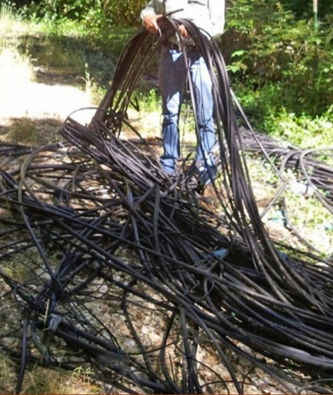
In an industry that wants to be seen as green, what are the real impacts? The answer is, no one knows for sure.
When you hear anti-cannabis groups complain about the impacts of legal cultivation, one concern that is often expressed is the impact on natural resources and the environment caused by growing cannabis. But how significant are those impacts, and what do they consist of? The answer is, it’s hard to say.
The research on impacts is limited and has been done almost exclusively on illegal grows. The fact they were illegal limited funding for research, limited what grows could be studied and creates significant questions as to whether the research findings can be predictive of the impacts from legal operations.
Sonoma County cannabis ordinances for legal cultivation have a strong environmental protection component, including pages of regulations about water and watersheds alone.
But are they enough? Research into environmental impacts of legal operations are in their infancy, so it may take time and research to determine best practices.
Bert Whitaker, the director of Sonoma County Regional Parks said the parks department has dealt with illegal grows in parks for 20 years, but calls them, “infrequent.”
“We’ve learned as time has gone by to be more assertive with neighboring property — being out there, being present, so that things aren’t happening that we aren’t aware of,” Whitaker said, adding that grows are more commonly found in open space districts not open to the public.
Adeline Yee from California State Parks reports similar experiences with Sonoma County properties. “It hasn’t been that huge of a problem,” she said. “Most of the efforts for cleanup are for what we call ‘environmental vandalism.’ When they do have illegal cultivation, we see increased traffic, water tanks being put up or they drop a hose in a river or creek, and a lot of times we have cleanup related to those things.”
“In some parks we have inholdings within some of the parks, which are islands of private property and often there is some cultivation, legal or illegal, on there,” Yee added.
Whitaker says that when illegal grows are found, the park service will either clean up the area themselves with volunteers, or bring in law enforcement and hazmat crews as needed. While these cleanups can have an effect on budgeting, the damage to an ecosystem is harder to quantify. Sometimes a cleanup just means pulling up tarps and piping, other times there is significant damage to soils, watersheds and plant and animal life.
Whitaker says since legalization, he has noticed greater concern from park visitors and neighbors, but not additional or increased damage to parklands. “It seems like, with legalization more neighbors and adjacent property owners are concerned about impacts,” he said.
“There is concern about the ecology of the area. It’s certainly resonating loud and clear in communities around our parks, that park visitors want to have a quality experience enjoying our outdoor spaces and they have concerns about adjacent legal grows due to aromas, security and view sheds,” Whitaker said. “People are curious, and we are taking this very seriously. We are taking a cautious, conservative approach to protect our parklands and the neighborhoods adjacent to them.”
What little research that was done into the environmental impacts of cannabis cultivation, albeit illegal grows versus legal ones, has had alarming findings. The Humboldt County-based 2016 peer-reviewed study, “Cannabis agriculture and the environment: a systematic, spatially-explicit survey and potential impacts” by Van Bustic and Jacob C. Brenner found that: “Popular media speculation about environmental impacts of cannabis agriculture in this region, especially impacts on water, is widespread, but empirical research is limited. The small body of scientific research points to profound negative consequences, including decreased stream flows, rodenticide poisoning of rare carnivores and high carbon emissions from greenhouses.”
However, the duo cautioned, “While these studies show negative impacts of cannabis production, they are all based on limited, non-random sampling in areas where cannabis production is known to be high. Thus, they cannot be used to infer impacts at broader scales.”
In October of 2017, Bustic and Brenner, along with Ian J. Wang, published a second study, “Cannabis, an emerging agricultural crop, leads to deforestation and fragmentation,” which compared the effects of cannabis cultivation to the effects of the timber industry.
“We found that although timber has greater landscape impacts overall, cannabis causes far greater changes in key metrics on a per-unit-area basis,” said Bustic in a statement.
On a per-unit-area basis, the cannabis grows resulted in 1.5 times more forest loss and 2.5 times greater fragmentation of the landscape, breaking up large, contiguous forest into smaller patches and reducing wildlife habitat.
“The results show how important it is to consider environmental impacts at different scales,” said Brenner, an associate professor in the Department of Environmental Studies and Sciences at Ithaca College, in a statement. “For example, current California law caps the size of outdoor cannabis production to one acre per parcel, to prohibit the development of industrial-scale cannabis operations outdoors. But, research is indicating an unintended consequence of this law may be small dispersed cannabis grows that edge out wildlife (and create forest fragmentation).”
The study points out that while the long-term effects of cannabis cultivation on the environment are unknown, the researchers concluded that land management and agricultural policy informed by further research may reduce effects, just as they have with other agricultural products.
“The few studies that have investigated specific practices associated with marijuana cultivation have identified potentially significant environmental impacts,” reads the abstract from the study.
“Cannabis requires high temperatures, strong light, highly fertile soil and large volumes of water — around twice that of wine grapes. A study of illegal outdoor grow operations in northern California found that rates of water extraction from streams threatened aquatic ecosystems and that water effluent contained high levels of growth nutrients, as well as pesticides, herbicides and fungicides, further damaging aquatic wildlife.”
But, county regulations on grows near parks and on their uses of and impacts on natural resources like water are strict and come with severe penalties. The question yet to be determined is what are the long-term impacts of legal cannabis agriculture, both as a standalone product and as compared to other agricultural products, such as grapes? More research is needed.








